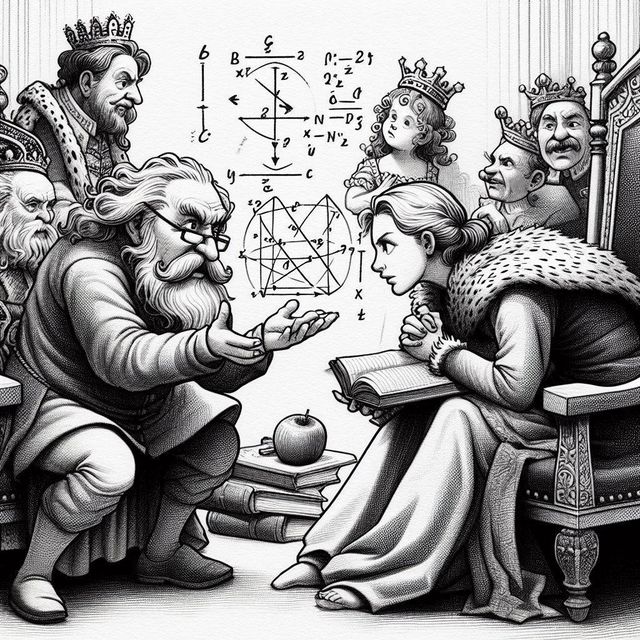-
Vijay Fafat
- Published on
A charming little tale about some mathematical fracas in the Kingdom of Nunvalia, and its resolution which left everyone, including a befuddled king, happy.
Ferdinand, the star pupil of the court mathematician, was in love with the mathematician’s daughter, Angelina. But one day, a minor disagreement arose between them which drove a wedge:
“This is how it all happened. The court mathematician and his pupil had been working together on a mathematical problem of huge dimensions, and they had differed as to the result of one of their computations. It was a small point indeed, but when professional honor is involved there is no such thing as agreeing to disagree, as ordinary people may, even on a very insignificant point.
” The square of the cube root of the logarithm of the sine of 45 (degrees) is 1.9731,” said the court mathematician, firmly.
” The square of the cube root of the logarithm of the sine of 45 (degrees) is 1.9732,” replied his pupil, with equal decision.
“I said one ten-thousandth,” retorted the court mathematician, warmly.
“Pardon me, two ten-thousandths,” answered the pupil”
The court mathematician glared at his pupil, and his pupil glared back in return.
“One,” almost shouted the court mathematician ; “and what is more, I command you not to contradict me.”
His pupil was silent, but held up two fingers. I will not describe how the anger of the court mathematician became a passion, and the passion a fury, and how in the latter state he ordered his pupil to leave the house and never dare to come there again.”
Obviously, this is a purposely farcical set-up designed to illustrate the silliness of some of the professional feuds (The correct answer to the question for a standard log base to 2, or e, or 10, would be less than 1. It would have been funnier if the author had used tan(45 degrees), because then, the actual answer would have been zero and it would have made for a sharper farce that the two great mathematicians were fighting over some fourth decimal place of a completely wrong answer…).
In any case, Ferdinand was now distraught, and in his lonesomeness in the royal garden, “sat disconsolate and sweet-heart-less under the trees of the royal gardens, bemoaning his hard fate.” In mathematically poetic mode, he moaned:
“Ah ! she is the locus of all good traits,” he murmured with a sigh. “Yes, her life is the curve toward which my own has been tending from the first. Once I believed mine to be the tangent to hers at finite distance ; woe is me that I should find that it is an asymptote.”
Right then, Princess Elsa, the third and youngest daughter of King Adolphus happened to stroll by. One thing led to another and the princess walked away with the impression that Ferdinand was in love with her, setting the stage for an interesting show-down.
Now, long ago,
“King Adolphus of Nunvalia, like many another king, had found it frequently very difficult to collect the taxes due him from his subjects. He had tried imprisonment and even beheading as punishments for non-payment, but for all that many of his people had continued to spend all their money just before the tax-collector came to them, and then what was to be done?”
After a hilarious analysis by economists and moralists, Adolphus had decided to solve the problem by implementing a lottery system for every tax payer - a large award for answering one question-of-the-year correctly. The scheme worked so well that it got institutionalized as an annual event.
In the year in question, the reward was to be the third finest ruby in Adolphus’s crown. And the question? The precise mathematical one over which the court mathematician and Ferdinand had a disagreement…
Through a complicated chain of events, Ferdinand came to believe that the “third finest ruby” meant the youngest princess, Elsa. Since he knew the precise answer, and was ready to take on the court mathematician in a public forum, he was tempted to win the competition, even if contentious, and obtain the princess’s hand in marriage, temporarily forgetting his love for Angelina. But at the last minute, good sense prevailed, some funny drama occurred and Ferdinand was united with Angelina after a spirited debate with the court mathematician about the “correct” answer.
An endearing little tale.
A note on the anthology. Williams College has had a long history of college magazine featuring fiction work. In 1900, the editors decided to publish an anthology of good fiction and verses which had appeared in Williams magazine from 1898 to 1900. The tale by Percival Henry Truman was one of them, written in 1898.
